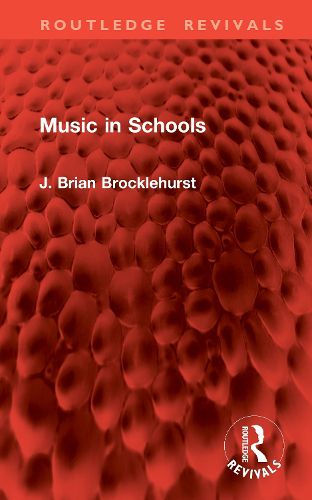Readings Newsletter
Become a Readings Member to make your shopping experience even easier.
Sign in or sign up for free!
You’re not far away from qualifying for FREE standard shipping within Australia
You’ve qualified for FREE standard shipping within Australia
The cart is loading…






First published in 1962, Music in Schools discusses all aspects of the teaching of singing in schools. The most effective methods of laying the foundations of musicianship are fully dealt with and ways are considered in which movements, speech, and simple instrumental playing can be used to develop children's musical literacy, aural perception, and creative ability.
Attention is given to the development of children's taste for, and in, music (including jazz and popular music) and stress is laid on the importance of children as active participants in the appreciation lesson, not simply passive spectators. The place of instrumental music in schools is considered fully and methods of teaching the playing of percussion instruments (rhythmic and melodic), recorders, bamboo pipes, harmonicas, and melodicas are examined. Suggestions are made concerning the formation of school brass bands and piano, string and wind instrument classes; advice is also given on the training and conducting of school orchestras.
Other subjects which receive attention include continuity in school music, the value of musical aptitude tests, the use of films and other visual aids, the provision of equipment for music rooms in schools and the place of music in the education of mentally and physically handicapped children.
$9.00 standard shipping within Australia
FREE standard shipping within Australia for orders over $100.00
Express & International shipping calculated at checkout
First published in 1962, Music in Schools discusses all aspects of the teaching of singing in schools. The most effective methods of laying the foundations of musicianship are fully dealt with and ways are considered in which movements, speech, and simple instrumental playing can be used to develop children's musical literacy, aural perception, and creative ability.
Attention is given to the development of children's taste for, and in, music (including jazz and popular music) and stress is laid on the importance of children as active participants in the appreciation lesson, not simply passive spectators. The place of instrumental music in schools is considered fully and methods of teaching the playing of percussion instruments (rhythmic and melodic), recorders, bamboo pipes, harmonicas, and melodicas are examined. Suggestions are made concerning the formation of school brass bands and piano, string and wind instrument classes; advice is also given on the training and conducting of school orchestras.
Other subjects which receive attention include continuity in school music, the value of musical aptitude tests, the use of films and other visual aids, the provision of equipment for music rooms in schools and the place of music in the education of mentally and physically handicapped children.